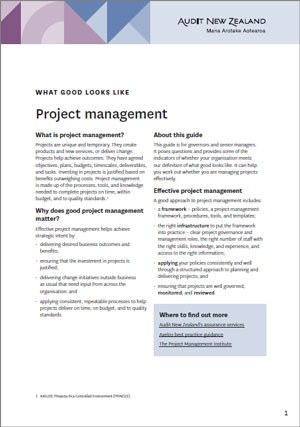What good looks like: Project management
This is part of our series on What good looks like, produced by our Specialist Audit and Assurance Services team.
What is project management?
 Projects are unique and temporary. They create products and new services, or deliver change. Projects help achieve outcomes. They have agreed objectives, plans, budgets, timescales, deliverables, and tasks. Investing in projects is justified based on benefits outweighing costs. Project management is made up of the processes, tools, and knowledge needed to complete projects on time, within budget, and to quality standards.1
Projects are unique and temporary. They create products and new services, or deliver change. Projects help achieve outcomes. They have agreed objectives, plans, budgets, timescales, deliverables, and tasks. Investing in projects is justified based on benefits outweighing costs. Project management is made up of the processes, tools, and knowledge needed to complete projects on time, within budget, and to quality standards.1
Why does good project management matter?
Effective project management helps achieve strategic intent by:
- delivering desired business outcomes and benefits;
- ensuring that the investment in projects is justified;
- delivering change initiatives outside business as usual that need input from across the organisation; and
- applying consistent, repeatable processes to help projects deliver on time, on budget, and to quality standards.
About this guide
This guide is for governors and senior managers. It poses questions and provides some of the indicators of whether your organisation meets our definition of what good looks like. It can help you work out whether you are managing projects effectively.
Effective project management
A good approach to project management includes:
- a framework – policies, a project management framework, procedures, tools, and templates;
- the right infrastructure to put the framework into practice – clear project governance and management roles, the right number of staff with the right skills, knowledge, and experience, and access to the right information;
- applying your policies consistently and well through a structured approach to planning and delivering projects; and
- ensuring that projects are well governed, monitored, and reviewed.
Where to find out more
Audit New Zealand’s assurance services
The Project Management Institute
| 10 questions | Indicators of what good looks like | |
|---|---|---|
| Framework | 1. Do you have a clear project management policy? |
|
| 2. Do you have an up-to-date project management framework? |
|
|
| Infrastructure | 3. Have you got enough staff, with the necessary expertise, in the right structure? |
|
| 4. Do you have a project management system that enables you to manage, monitor, and report project activities? |
|
|
| Application | 5. Is there a good approach for establishing project mandate, business case, and start-ups? |
|
| 6. Are good project management processes being applied to projects in progress? |
|
|
| 7. Is there good reporting of projects in progress? |
|
|
| 8. Is there a structured approach to project handover and benefits realisation? |
|
|
| Monitor and review | 9. Do you review your approach and what you have learned? |
|
| 10. Are governors informed enough to assess whether project management is effective? |
|
|
1: AXELOS: PRojects IN a Controlled Environment (PRINCE2).
